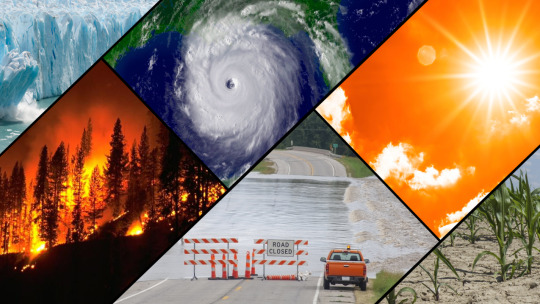#Climate Change Mitigation
Explore tagged Tumblr posts
Text
#good news#nature#science#environmentalism#environment#climate change#climate change mitigation#climate crisis#climate hope#energy#renewable power
116 notes
·
View notes
Text
#alaska#alaska native tribes#biodiversity#braiding sweetgrass#candice gaukel andrews#climate change#climate change mitigation#conservation#covid 19#drought#ecosystems#environment#executive order 14072#forests#global warming#indigenous knowledge#natural habitat adventures#nathab#nature#plants#remote#robin wall kimmerer#science#science and environment#scientific research#shellfish#social justice#technology#trees#western science
4 notes
·
View notes
Text
#deforestación#deforestation#global warming#climate action#climate crisis#climate deniers#climate change mitigation#climate change#climate catastrophe#climate emergency
3 notes
·
View notes
Text
Climate Change Solutions: AI-Powered Innovations for a Greener World
Introduction Climate Change is the defining challenge of our time, with consequences that touch every aspect of our lives. As the world grapples with this monumental issue, Artificial Intelligence (AI) has emerged as a key player in the battle against global warming. In this blog post, we’ll explore how AI is being used to model, predict, and address climate change, offering innovative solutions…

View On WordPress
#AI and Climate Change#AI for Climate Action#AI in Climate Modeling#Climate change#Climate Change Adaptation#Climate Change and Technology#Climate Change Mitigation#Climate Change Solutions
2 notes
·
View notes
Text
From Roots to Policy: How Plants and Laws Can Shape a Sustainable Future

View On WordPress
#adaptation#adaptive survival#afforestation#biodiversity#Biodiversity Conservation#biodiversity data#Canada#Canadian sustainability#Carbon Footprint Reduction#Climate Action#climate action goals#Climate Advocacy#climate change#climate change education#climate change mitigation#climate change policy#Climate Justice#Climate Mitigation#climate policy#climate policy reform#Climate Resilience#climate solutions#collaboration#Community Action#Community Engagement#Conservation Efforts#Conservation Strategies#developmental plasticity#Earth’s ecosystems#ecological balance
0 notes
Text

Sustainable urban development is crucial as cities expand and energy demands grow. Renewable energy systems, such as solar, wind, and hydropower, offer cleaner alternatives to fossil fuels, helping reduce carbon footprints and combat climate change. MKCE focuses on educating students through hands-on projects, equipping them to design and implement efficient energy systems. These systems provide economic benefits, enhance energy security, and improve public health by reducing air pollution. Despite challenges like high initial costs and infrastructure gaps, innovations like smart grids and energy storage are transforming urban energy management. MKCE prepares students to tackle these challenges and contribute to global sustainability goals. The adoption of renewable energy is essential for achieving a cleaner, healthier future. Through education and innovation, MKCE plays a key role in shaping future leaders in renewable energy. The integration of renewable energy is vital for building resilient and sustainable cities. Together, we can transition to a greener, more sustainable urban future. To Know More : https://mkce.ac.in/blog/the-role-of-renewable-energy-systems-in-sustainable-urban-development/
#private college#best engineering college in karur#engineering college#top 10 colleges in tn#mkce college#mkce#libary#mkce.ac.in#best engineering college#engineering college in karur#Energy Security#Carbon Footprint#Green Energy#Climate Change Mitigation#Public Health and Clean Energy
0 notes
Text
India has secured a spot among the top 10 global climate performers, marking a significant achievement in its efforts to combat climate change. Through ambitious policies, renewable energy growth, and sustainable practices, India is leading the way towards a greener future, setting an example for nations worldwide.
#top 10 climate performers#climate action#global climate rankings#environmental sustainability#India climate performance#climate change#climate leadership#sustainable development#green initiatives#India environmental efforts#climate policy#carbon emissions reduction#climate change mitigation#India climate progress#TheJuniorAge KidsNewspaper ChildrenNewspaper#Newspaper For Kids Newspaperforchildren Kids Newspaper India ChildrenNewspaperInIndia
0 notes
Text
The health effects of global warming & climate change
Global warming isn’t just melting glaciers; it’s reshaping human health with heatwaves, disease spread, and polluted air.
Global warming isn’t just about melting glaciers and rising sea levels—it’s a profound challenge to human health. From heatwaves scorching urban landscapes to vector-borne diseases spreading in unexpected ways, the health effects of global warming and climate change are becoming increasingly hard to ignore. This isn’t an abstract problem for future generations; it’s a pressing issue right…
0 notes
Text
Sun Life Foundation Advances Environmental and Social Causes with Key Initiatives
Sun Life Financial-Philippines Foundation, Inc. (Sun Life Foundation) continues its commitment to environmental sustainability and community health development through a series of impactful initiatives. These include a new mangrove conservation project, a tree planting drive in La Mesa Watershed, and the turnover of Barangay Health Stations in Central Luzon. As the philanthropic arm of Sun Life…
#Barangay Health Stations#climate change mitigation#community development#environmental sustainability#healthcare access#La Mesa Watershed#mangrove conservation#press release#Sun Life Foundation#sun life philippines#tree planting
0 notes
Text
Empowering Youth in Agriculture: How Digital Agripreneurs Are Revolutionizing Extension Services in Kenya
Discover how Kenya’s new agripreneurs model is empowering youth to provide digital extension services to farmers, revolutionizing agricultural productivity and market access. Learn how the Ministry of Agriculture is leveraging technology and digital platforms to enhance agricultural extension services, bridging the gap between research and farmers. Explore how digital agripreneurs are…
#agri-food systems#agricultural extension symposium#agricultural market access#agricultural policy#agricultural productivity#Agricultural technology#agripreneur model#climate change mitigation#cooperative societies in farming#digital agriculture#digital platforms for farmers#extension services#Farmer Support#farming innovation#KeFAAS#Kenya Agriculture#KIAMIS#Ministry of Agriculture Kenya#public-private dialogues in farming#YOUTH IN FARMING
0 notes
Text
Impact of Biodiversity Loss on Human Survival: Alarming 90% Decline
Photograph by Author Biodiversity is crucial for our survival, providing food, fresh air, and aesthetic value. Nevertheless, there’s an alarming 90% biodiversity loss in certain hotspots, caused by habitat destruction and industrial expansion. Human intervention, natural calamities, and man-animal conflicts are also contributing to this loss, leading to the dangerous era of Holocene…

View On WordPress
#Biodiversity#Biome#climate#Climate change mitigation#diversified living world#earth#energy#environment#eternal source of energy#Fauna#Flora#Food-web#genetic material#Genetics#India#loss of biodiversity#man animal conflict#mangrove#marshland#natural calamities#sun#wetland
0 notes
Text
#good news#science#environmentalism#nature#environment#epa#climate change#climate change mitigation#climate legislation#global climate change#conservation
13 notes
·
View notes
Text
Artificial Intelligence for Climate Action
Artificial Intelligence (AI) is transforming various sectors, and its impact on climate change mitigation is becoming increasingly significant. By leveraging AI, we can develop more efficient energy systems, enhance environmental monitoring, and foster sustainable practices. This blog post explores how AI is being used to curb climate change. AI for Renewable Energy Improvement One of the…

View On WordPress
#AI and Climate Change#Artificial Intelligence#Carbon Capture and Storage#Climate Change Mitigation#Climate Modeling#Disaster Response#Environmental Monitoring#Precision Agriculture#Renewable Energy Optimization#Sustainable Technology
0 notes
Text
Clearly, something is wrong with this dude.
#climate change mitigation#climate deniers#climate action#climate crisis#climate change#global warming#corrupt rich people#corrupt system#secret society#pure evil
2 notes
·
View notes
Text
Happy Mangrove Ecosystem Conservation Day! 🌿🌊
Happy Mangrove Ecosystem Conservation Day! 🌿🌊 Celebrate the beauty and importance of mangroves. Let's protect these vital ecosystems that support biodiversity and safeguard our coastlines. #MangroveConservation #ProtectNature #EcosystemPreservation
Introduction Happy Mangrove Ecosystem Conservation Day! 🌿🌊 Celebrated annually on July 26th, this day is dedicated to raising awareness about the critical importance of mangrove ecosystems and the need to protect and preserve them. Mangroves are unique coastal forests that provide essential benefits to the environment, support biodiversity, and safeguard our coastlines from erosion and storms.…
#biodiversity#climate change mitigation#coastal protection#ecosystem preservation#environmental awareness#mangrove conservation#Mangrove Ecosystem Conservation Day#protect nature
0 notes
Text
Honoring Richard St. Barbe Baker on World Humanitarian Day 2023

View On WordPress
#Canada#ceremonial planting#Climate Action#climate change mitigation#Climate Justice#Climate Resilience#Community Action#community collaboration#Community Engagement#Community Involvement#compassion#CULTURAL HERITAGE#cultural integration#cultural respect#Dance of the Trees#desertification#Ecological Awareness#ecological balance#ecological initiatives#Ecological preservation#ecological solutions#Ecosystem Restoration#environment#Environmental Activism#environmental challenges#Environmental Champions#Environmental Education#environmental heroes#environmental impact#environmental justice
0 notes